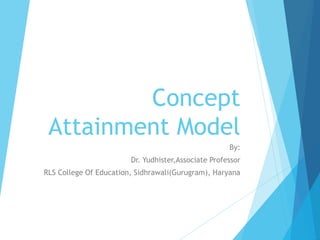Concept attainment model
This document provides an overview of the concept attainment model, a learning model developed by Jerome Bruner, Goodnow and George Austin in 1956. The concept attainment model is based on their research on thinking and aims to develop conceptual learning in students. It introduces students to the nature of concepts and provides training for concept attainment and clarification of known concepts. The model involves three phases - presenting examples to identify a concept, testing students' attainment of the concept, and analyzing student thinking strategies. The teacher's role is to support student hypotheses and focus attention on conceptual analysis. The model uses positive and negative examples to help students acquire new concepts through inductive reasoning.

Recommended
Recommended
More Related Content
What's hot
What's hot (20)
Similar to Concept attainment model
Similar to Concept attainment model (20)
Recently uploaded
Recently uploaded (20)
Concept attainment model
- 1. Concept Attainment Model By: Dr. Yudhister,Associate Professor RLS College Of Education, Sidhrawali(Gurugram), Haryana
- 2. Concept Attainment Model This module includes Introduction of concept attainment model Meaning of a concept and its elements Basic assumptions of this model Focus Syntax Social system Principles of reaction Support system Application
- 3. Learning outcomes: After completion of this module the learners will be able to recall the meaning of a concept cite examples of different concepts enlist basic assumptions of this model explain various types of this model analyze different elements of this model Describe various phases of syntax of this model
- 4. Concept Attainment Model This model belongs to information process source. Developed by Jerome Bruner, Goodnow and George Austin in 1956. Based on their research work “A study of thinking”
- 5. Definitions of a Concept Morgan, “A concept is a process representing a common property of an object or event.” Woodworth, “Concept is an important tool of thinking and it is sum total of what you know about the object.”
- 6. Elements of a Concept Name Examples- positive and negative Attribute- esssential and non essential Attribute value Rule
- 7. Basic Assumptions Our environment is very complicated. It has many types of objects. Complexities of environment is reduced by categorization. The process of categorization reduces the need of ne and continuous learning. All the concepts are a result of similar thinking process although may vary from culture to culture.
- 8. Categorizing has two components-act of concept formation and act of concept attainment. In concept attainment concept is determined in advance and task is to determine elements. Concept formation is the act where new concept is formed. Concept formation and concept attainment differ in thinking process.
- 9. Focus of CAM To develop conceptual learning among students. To acquaint students about nature of concept. To develop awareness towards constructive skills related to thinking. To provide training for concept attainment. To clarify the already known concepts.
- 10. Types of CAM Reception oriented Model Selection oriented Model Unorganized Material Model
- 11. Phase –One Presentation of data and identification of concept Teachers presents well labeled examples. Students compare attribute in positive and negative examples. Students formulate and test hypotheses. Students state a definition according to attribute.
- 12. Phase -Two Testing Attainment of Concept Students identify additional unlabelled examples as yes or no Teacher confers hypotheses, name concept and restate. Students generate examples.
- 13. Phase -Three Analysis of thinking Strategies Students describe thoughts. Students describe role of hypotheses and attributes. Students discuss types and number of hypotheses.
- 14. Social System Well structured. Freedom is given to students for carrying out their own thinking. Co-operating sharing of teaching –learning. Formulate hypotheses and test on basis of data.
- 15. Principles of Reaction Teacher is to remain supportive to students hypotheses. He has to maintain record by keeping track of hypotheses. He is to remain supportive for turning students attention towards analysis of concept. Encourages analysis of various strategies rather attempt to seek best strategies.
- 16. Support System Well thought examples marked as positive and negative. Students have to describe the characteristics of examples(marked yes or no). Flannel board be used the present various parts of evolved defination and explanation of concept.
- 17. Application Helps students to acquire new concept. Used to teach concepts related to all subjects. Inductive thinking confined to topic determine concept on the basis of examples. Used for students of all age group and grade.
- 18. THANKS